
The Marantz 2226 is one of the great low powered Marantz receivers. At 26 watts per channel it’s not a powerhouse but the lower powered Marantz receivers are known for their sweet sound. Marantz introduced the 2226 in 1977, at a retail price of $329.99, and it stayed on the market until 1979.

The 2226 has no more than 0.3% total harmonic distortion and a damping factor of 45. It’s direct coupled amplifier design provides very high damping factors at low frequencies and great low frequency response.
The 2226 came with a simulated wood grain vinyl covered metal case but the purchaser had the option to buy the WC-122 wood cabinet if they wanted.
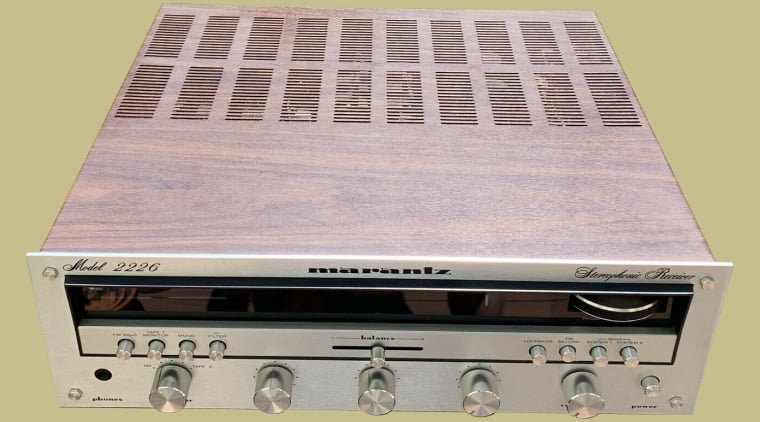
The tuning section has a dual-gate MOSFET FM front end and 3 gang tuning capacitor. It’s a sensitive and very quiet tuning section. It utilizes a phase locked loop (PLL) FM demodulator, and ceramic IF filters and IC amplifier system.
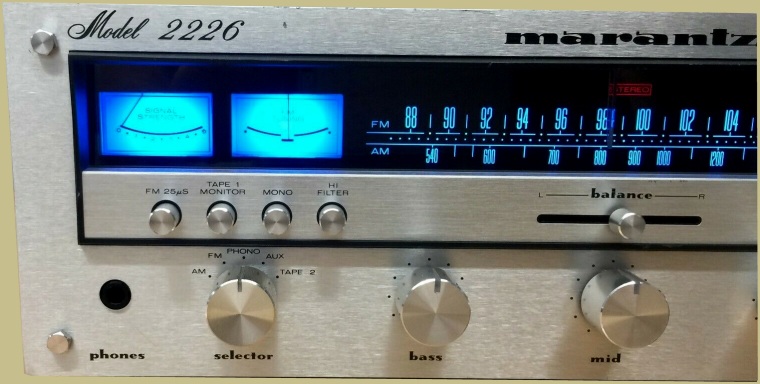
The 2226 has bass, mid and treble tone controls. They’re a Baxandall design which means they focus the boost or cut on the lowest bass or highest treble frequencies. The mid control therefore allows the user more control over the mid range frequencies without affecting the bass or treble much. The balance control is a slider positioned at the center of the face plate. Of course it has the distinctive gyro-touch flywheel tuning knob as well.

Specifications:
- Tuning range: FM, MW
- Power output: 26 watts per channel into 8Ω (stereo)
- Frequency response: 15Hz to 60kHz
- Total harmonic distortion: 0.3%
- Damping factor: 45
- Input sensitivity: 1.8mV (MM), 180mV (line)
- Signal to noise ratio: 75dB (MM), 84dB (line)
- Output: 775mV (line), 1.5V (Pre out)
- Semiconductors: 3 x IC, 45 x transistors, 29 x diodes, 1 x FET
- Dimensions: 440 x 137 x 365mm / 17 5/16 x 5 3/8 x 14 3/8 inches
- Weight: 12kg / 26.4 lbs
There is a black face plate version of the 2226 as well. It’s far more rare than the silver faced version. Beautiful!

The large over sized transformer is part of Marantz’s heavy duty power supply design. It’s a dual balanced positive and negative power supply that powers the amplifier stages symmetrically. Notice the two large capacity capacitors and heat sink.
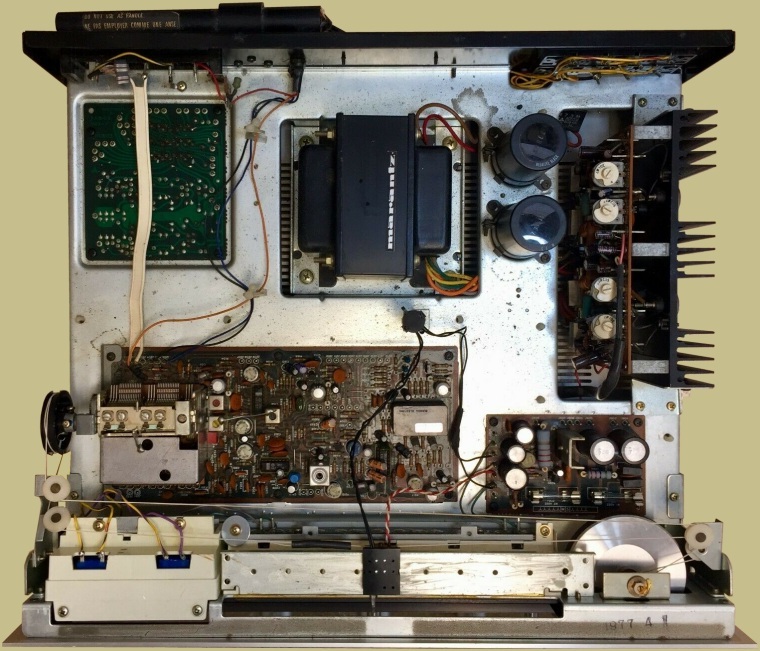
Don’t confuse the 2226 with the 2226B. A quick look will show a number of differences in the layout of the controls. The 2226B has a regular knob to control balance as opposed to the slider on the 2226. The dial face is black on the 2226 and almost white on the 2226B. However, the power output is roughly the same for both receivers with some specs showing 29 wpc for the 2226B. Usually the ‘B’ designated receivers were produced a little bit later than the non-B versions, though many times were on the market at the same time, and had either major or minor aesthetic changes and some minor internal variations. As for which version is better? Well, that’s for your ear to decide.

The Marantz 2226 is a great low powered receiver. The 26 watts per channel is plenty to power most speakers and the receiver produces a beautiful warm sound. It’s a nice looking receiver too. Especially the black version. Definitely a stereo worth acquiring if you have the chance.
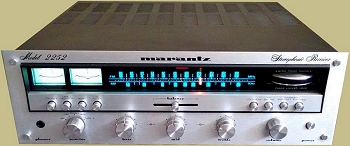
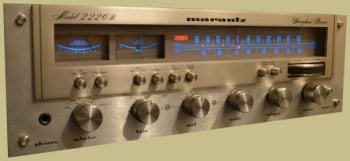
I’m looking at this model from Craigslist……what should I look out for….or how should I test it before buying.
Sorry….I’m a little new at buying old Marantz that hasn’t been reconditioned.
What do you suppose is a major “old age” problem for this model to look out for?
I suspect, it would need to be reconditioned by a shop…adding how much to the cost?
Thanks for any reply you can muster up.
Check out the Marantz thread at Audiokarma.org. There is tons of information on Marantz gear there. The thread is HERE. Not too many common problems with the 2226. It’s a well built receiver and well laid out inside. Usually the potentiometers are dirty which will result in scratchy sound when turning the vol knob or other knobs or switches. That’s a fairly easy fix with some DeOxit and cleaning though the vol pot is not that easy to get to. Bulbs tend to go out as well. Not very hard to change those on the 2226. Make sure both channels are equal volume. Make sure the meters work. The 2226 is easy to work on so most problems shouldn’t cost to much to have fixed if it’s something beyond your capabilities. In my are it’s about $125 for a basic cleaning and adjustment. Repairs are more.
Check out the Audiokarma thread. Lots of Marantz info there. You might want to post the same question there. Good luck!
Thanks for your response. At this date, we’re post Covid lockdown and…just wondering have prices stayed the same on vintage gear? There seems to be inflation with all that Stimulus money flowing. I noticed Smart Tv’s didn’t nose dive in price like last year around April. Have you noticed any changes in prices?
Hey man, you can’t go wrong with the 2226. I bought mine around 7 years ago and tore it apart, cleaned the pots and replaced the lamps with LED’s. My capacitors were all in good shape but watch for bulges in the top of them, that’s a sure sign of imminent failure.
One thing I will say, if you connect this receiver to efficient speakers it will ROCK. My current setup is a NAD M33 with Prestige 95F (Paradigm) speakers, but for a change I just booked up the Marantz 2226 and using the M33 simply as a streamer. The Prestige 95F speakers are rated at 94db efficiency and this little receiver CRANKS with the sweetest sound and just tonnes of powerful bass. Amazing.
I mean, I love my NAD M33 but it is hyperdetailed with these speakers. The 95F speakers with the Marantz powering them is heaven.
Are you certain on those dates of manufacture? I recall buying a 2226B in 1977, so wouldn’t that have supplanted the non “B” version?
I had both, my 2226 was dated Sept 1977 and the 2226b I have now is dated 1978
It’s production ceased in late 1978 to make room and retooling for the new 1979 model line…
I have a full collection of their receivers from 1968 the numeral models ie , 18. 19 USA made and the Japanese Numerial versions ie 25,26,28, lower class units and the 22 series flagship model to 1979 where I stopped collecting units do to family needs and unit cost..
The only issue with any Marantz and this includes the SD line of 1980 is age..Caps go bad throwing voltages off or downright failing since caps have a average use life of 20 yrs, most units are twice that age and if they haven’t failed the unit is noisy and in need of a full restoration..this goes for any brand..
Never buy a Unit that has been advertised as had maintenance done on it unless you plan to ship it out to be restored and never pay the stupid price the uneducated flippers on eBay ask for their estate sale finds..Their prices are targeted to inexperienced buyers and often reflect what it SHOULD BE once professionally restored ie after buying a unit and sending out for a $650 restoration job…Personal I’d never buy from a flipper, I’d put them out of business anytime I can since they ruined the audio market for millions of new enthusiasts….